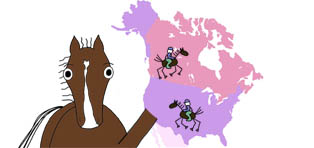Insulin doping
Spectroscopy Now journal
With the 2012 Olympic Games on the horizon, the thoughts of the administrators will be turning to drug testing, in an attempt to ensure that all medals are won on a fair and equal footing. This seems to become more difficult year-on-year, with the illicit use of peptides and proteins adding to the burden of the testing labs.
One of the more popular performance enhancers is the hormone insulin, a small protein which can increase muscle size and improve endurance. Insulins have been banned by the IOC and WADA for more than ten years.
The effects of insulin are the same in horses as in humans, with the result that insulin has also been banned by the international horseracing authorities. However, policing the ban is no trivial matter. There are no equine insulin products on the market so those unscrupulous operators have to resort to insulin from other species.
There are some human insulin analogues, such as Humalog and Novolog, which are attractive to the doper because they are fast-acting and are excreted rapidly. Bovine and porcine insulin are also doping candidates, because they are structurally very similar to equine insulin with only 1-3 amino acid residues different. The Hong Kong Jockey Club are very active in equine doping research and scientists there recently published a method for the detection of insulin analogues in equine plasma. Now, they have developed a parallel procedure for insulins in equine urine, the most common biological matrix used for doping research.
The method, published by Emmie Ho, Terence Wan, April Wong, Kenneth Lam and Brian Stewart, is the first reported for the analysis of human or animal urine for foreign insulins following covert administration.
Insulins from different species distinguished by MS
The team selected five insulins for analysis, as well as endogenous equine insulin. Human, porcine and bovine insulin were included, along with Humalog and Novolog, all of which differ from equine insulin by up to four amino acid residues at the most.
Equine urine was spiked with a mixture of the five exogenous insulins which were subsequently isolated by immunoaffinity purification, using anti-human insulin antibodies bound to magnetic beads. Following elution from the beads, they were analysed intact by liquid chromatography-tandem mass spectrometry using electrospray ionisation.
For speed of analysis and to reduce possible losses during processing, the researchers chose not to employ enzymatic digestion, or even reduction of the two disulphide bonds which link the A and B peptide chains of insulin. As it happened, the retention times and tandem mass spectra showed sufficient variations to allow the six insulins to be differentiated, even though they are structurally very closely related.
All six insulins eluted within 31-33 minutes. The multicharged molecules at [M+5H]5+ were chosen for fragmentation and every insulin produced a common product ion at m/z 136.3, corresponding to the same tyrosine immonium ion. These transitions were selected for screening, with several other characteristic transitions plus the retention times used for unambiguous identification of each insulin.
Human insulin and Humalog have identical molecular masses, the only structural differences being the switching of lysine and proline residues between two adjacent positions in chain B. Nevertheless, they were distinguished due to different retention times and markedly different product-ion spectra.
The detection limits of the technique were around 8.6 fmol/µL, which is equivalent to less than 0.05 ng/mL.
The method was used to screen equine urine following the administration of human insulin, at a dose equivalent to that typically used by human abusers. Even at this low level (10 IU), it was clearly detected and confirmed, illustrating the applicability of the method.
The researchers also carried out some metabolic studies of the five exogenous insulins in horse liver microsomes. All of the metabolites identified corresponded to compounds with intact disulphide bonds and truncated B chains of various lengths.
The immuoaffinity extraction procedure succeeded in trapping all of the metabolites, so they all constitute additional potential targets for screening methods. However, with the low insulin dose used in these studies, the metabolites could not be detected.
Any doping of horses with insulin will have to use products from other species, as there are no equine insulin preparations. This research is the first published report that exogenous insulin can be detected in equine urine following administration and demonstrates that urine testing would be an appropriate route for insulin doping tests in horses.

1 comment:
Equine insulin test able to detect even the smallest amount of insulin in horse urine has recently been developed to aid in the detection of insulin doping in racehorses. Thanks for providing a lot of information about this insulin.
Post a Comment